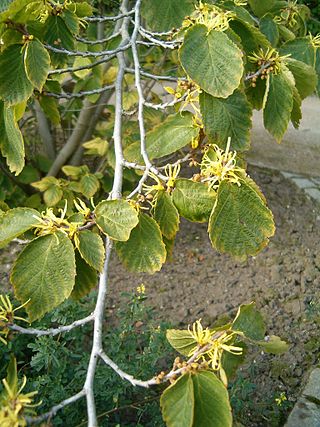
Viburnum lentago, the nannyberry, sheepberry, or sweet viburnum, is a species of Viburnum native to North America.

Aralia spinosa, commonly known as devil's walking stick, is a woody species of plant in the genus Aralia of the family Araliaceae. It is native to eastern North America. The various names refer to the viciously sharp, spiny stems, petioles and even leaf midribs. It has also been known as Angelica-tree.
Mallotus pleiogynus is a species of plant in the family Euphorbiaceae. It is a tree that grows to 43 m (141 ft) tall and is native to New Guinea.

Cornus alternifolia is a species of flowering plant in the dogwood family Cornaceae, native to eastern North America, from Newfoundland west to southern Manitoba and Minnesota, and south to northern Florida and Mississippi. It is rare in the southern United States. It is commonly known as green osier, alternate-leaved dogwood, and pagoda dogwood.

Cardamine hirsuta, commonly called hairy bittercress, is an annual or biennial species of plant in the family Brassicaceae, and is edible as a salad green. It is common in moist areas around the world.

Kigelia is a genus of flowering plants in the family Bignoniaceae. The genus consists of only one species, Kigelia africana, which occurs throughout tropical Africa. The so-called sausage tree grows a poisonous fruit that is up to 60 cm long, weighs about 7 kg, and resembles a sausage in a casing.

Hamamelis virginiana, known as witch-hazel, common witch-hazel, American witch-hazel and beadwood, is a species of flowering shrub native to eastern North America, from Nova Scotia west to Minnesota, and south to central Florida to eastern Texas.

Annona senegalensis, commonly known as African custard-apple, wild custard apple, wild soursop, abo ibobo, sunkungo, and dorgot is a species of flowering plant in the custard apple family, Annonaceae. The specific epithet, senegalensis, translates to mean "of Senegal", the country where the type specimen was collected.

Melicope micrococca, commonly known as hairy-leaved doughwood or white euodia, is a species of shrub or slender tree in the family Rutaceae and is endemic to eastern Australia. It has trifoliate leaves and white flowers borne in panicles in leaf axils.

Celtis africana, the white stinkwood, is a deciduous tree in the family Cannabaceae. Its habit ranges from a tall tree in forest to a medium-sized tree in bushveld and open country, and a shrub on rocky soil. It occurs in Yemen and over large parts of Africa south of the Sahara. It is a common tree in the south and east of southern Africa, where the odour given off by freshly-cut green timber is similar to that of Ocotea bullata or black stinkwood.

Cardiospermum halicacabum, known as the lesser balloon vine, balloon plant or love in a puff, is a climbing plant widely distributed across tropical and subtropical areas of Africa, Australia, and North America that is often found as a weed along roads and rivers.

Brunfelsia latifolia, commonly known as yesterday-today-tomorrow and kiss me quick, is a species of flowering plant in the nightshade family. Endemic to Brazil, it is an evergreen shrub that becomes semi-deciduous in cooler areas and grows up to 1.8 meters in height.

Senna italica, the Port Royal senna, Italian senna, or Senegal senna is a legume tree in the genus Senna. It is recognized by many other common names based on the regions it grows in. In India, it is used to produce a powder for treating hair-related diseases which is known as “neutral henna”. Whereas, in some parts of the world, this species is cultivated for the leaves which yield the drug senna, known commonly as Senna glycoside, which in turn is the base for a laxative. Senegal senna is easily distinguishable through its many distinctive features. There are 3 subspecies of this plant based on the size of the inflorescence and the length of the petiole. The subspecies are italica, micrantha, and arachoides. In many regions, this plant is cultivated commercially and medicinally.
Hypodaphnis is a monotypic genus of flowering plants of the family Lauraceae. Its only extant species, Hypodaphnis zenkeri, is native to Gabon. Although only one living species is known, fossils of some species of this genus are present in North America, especially in Northern Mexico. In most phylogenetic analysis, Hypodaphnis appears as the basal branch, the sister group of the rest of the family Lauraceae.
Zanha golungensis, commonly known as the smooth-fruited zanha, is a species of plant in the family Sapindaceae that is native to Africa. It is used locally for timber and herbal medicine.

Allophylus decipiens (E.Mey.) Radlk., commonly known as the bastard taaibos, is a multi- or single-stemmed, small, evergreen tree about 3–4 m in height occurring in coastal forest, fringe forest and thickets, and wooded ravines and streams. Found up to 800 m in the southern coastal regions of the Cape Province, KwaZulu-Natal, Eswatini, along the escarpment forest of Mpumalanga, including Soutpansberg and in Mozambique. There are some 219 species in the genus of Allophylus.
Zanha is a small genus of plants in the family Sapindaceae that are native to Africa.

Otholobium lanceolatum is a small subshrub of up to 20 cm (7.9 in) high, that is assigned to the Pea family. It has up to 7 horizontal stems with raised tips, few hairless, alternately set leaves with only one leaflet and clusters of 15-27 white, pea-like flowers with a purple tip near the top of the short, seasonal shoots. It is endemic to one site near Caledon, South Africa. Flowers only appear in November and December within one year after a fire destroyed the vegetation.
Zanthoxylum austrosinense, or South Chinese Sichuan pepper, is a woody plant in the family Rutaceae and is native to southern China.

Cupaniopsis foveolata, commonly known as narrow-leaved tuckeroo, white tamarind or toothed tuckeroo, is a plant in the maple and lychee family Sapindaceae found in eastern Queensland and New South Wales, Australia.















